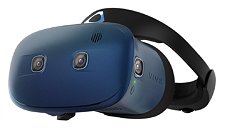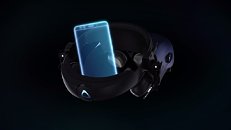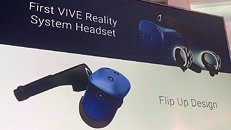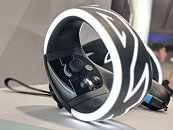Wednesday, January 9th 2019

HTC Announces the Vive Cosmos Stand-Alone(ish) VR Headset at CES 2019
The pace of innovation can't stand still, and if there's one space that needs cost-cutting and new product injection to increase its install base is the VR ecosystem. HTC took to CES 2019 to reveal their new take on the VR, a semi-portable VR headset that has been designed not only for room-scale VR, but also for home use and, cryptically, on-the-go (holy moly, the headset flips up towards your forehead!).
Apparently, the Cosmos will have the ability to be powered by your smartphone and perhaps other devices - not all that surprising when you think of the RAM and computing power that it holds right in the palm of your hands (I'll say. My smartphone is a much better performer than my work PC...). And HTC says the Cosmos will be their sharpest VR headset ever - which should mean that it should feature higher resolution than the Vive Pro's 2880×1600 (1440×1600 per eye) display. A smartphone would likely only be able to power some sort of augmented reality graphics on that resolution, though - but I might be wrong.The Cosmos will take a modular approach from the ground-up, which means additional equipment (maybe a full wireless solution) and other attributes (which, we don't know) will be able to be attached to the headset in the future. It features inside-out tracking (needed for that on-the-go capability, unless you're walking around with a circle of Lighthouse base stations) and new controllers a la Oculus' Quest.There's also a new Vive platform coming up, the Vive Reality System, which serves as both user interface, VR browser, digital storefront (with VR games and other content being available) and a social service. Support for Steam VR is still present. Pricing, you ask? That's likely the most important question, though there's no answer to that just yet. But considering the adoption rate for VR, and absent the launch of a killer app (like a real Halo game, I mean, come on, why don't they see it?) a market penetration strategy with a democratization of the entry point towards lower pricing might be the required jolt for VR as a whole.
Source:
Upload VR
Apparently, the Cosmos will have the ability to be powered by your smartphone and perhaps other devices - not all that surprising when you think of the RAM and computing power that it holds right in the palm of your hands (I'll say. My smartphone is a much better performer than my work PC...). And HTC says the Cosmos will be their sharpest VR headset ever - which should mean that it should feature higher resolution than the Vive Pro's 2880×1600 (1440×1600 per eye) display. A smartphone would likely only be able to power some sort of augmented reality graphics on that resolution, though - but I might be wrong.The Cosmos will take a modular approach from the ground-up, which means additional equipment (maybe a full wireless solution) and other attributes (which, we don't know) will be able to be attached to the headset in the future. It features inside-out tracking (needed for that on-the-go capability, unless you're walking around with a circle of Lighthouse base stations) and new controllers a la Oculus' Quest.There's also a new Vive platform coming up, the Vive Reality System, which serves as both user interface, VR browser, digital storefront (with VR games and other content being available) and a social service. Support for Steam VR is still present. Pricing, you ask? That's likely the most important question, though there's no answer to that just yet. But considering the adoption rate for VR, and absent the launch of a killer app (like a real Halo game, I mean, come on, why don't they see it?) a market penetration strategy with a democratization of the entry point towards lower pricing might be the required jolt for VR as a whole.





6 Comments on HTC Announces the Vive Cosmos Stand-Alone(ish) VR Headset at CES 2019
That’s exactly what I saw in the Qualcomm reference headset, which had a very impressive pair of displays which I don’t believe I’ve ever seen before.
These new displays are LCD and running up to 90Hz with a resolution of 2,160 × 2,160 per-eye, a huge step up in pixels (2x!) over leading displays in headsets like the Vive Pro at 1,440 x 1,600 (even before talking about subpixels)."
If true, I would buy it.
I still think the HMD to beat is Valve's leaked HMD, but we will see.
A VR HMD that connects to the PC via tether (and or wireless) thus taking advantage of the prowess of the PC and can also function in a mobile capacity for travel. I was also suggesting "outside in" tracking to help push past occlusion as an option for PC operation in addition to "inside out" tracking (in other words use both simultaneously as a check and balance). For mobile (without the PC) users would have to make duo with "Inside out" only tracking.
Any new HMD would also need:
Higher resolution
Larger FOV
Diminished Screen Door Effect
Rock solid tracking
There is more that can be added but expectations should be kept reasonable. While 4K resolution per eye would be great there are very real limitations with respect to the GPU computational prowess one would need to drive it at no less then 90Hz for VR. That has to be consistence from game title to game title as well.
My microwave is more powerful than the hardware that powered the moon mission. In modern terms, any half decent PC destroys a phone! What are you using... an IBM PS1 386 with 512kb RAM and DOS 4.01?